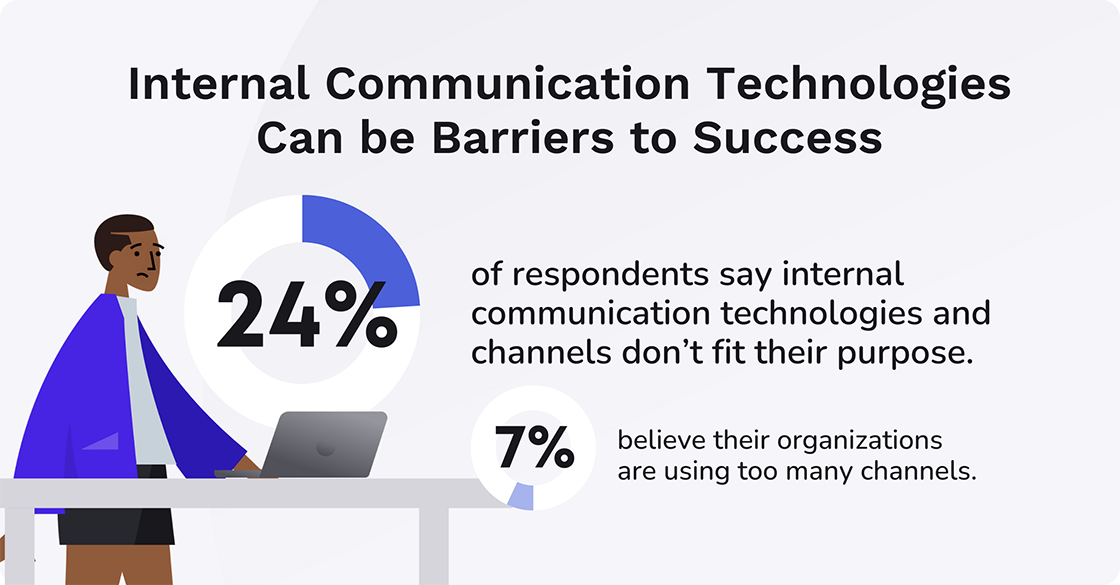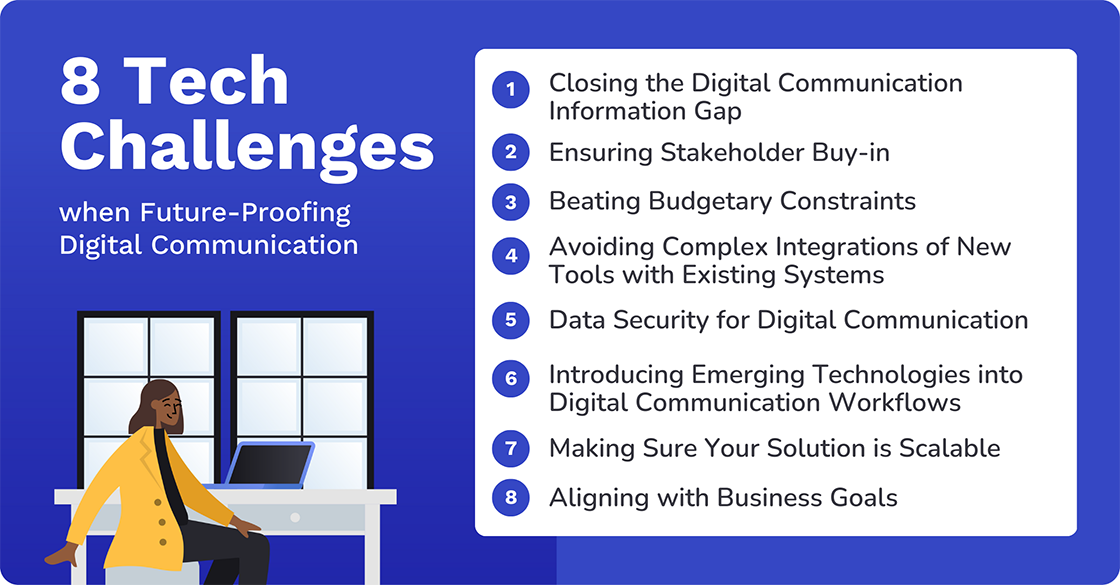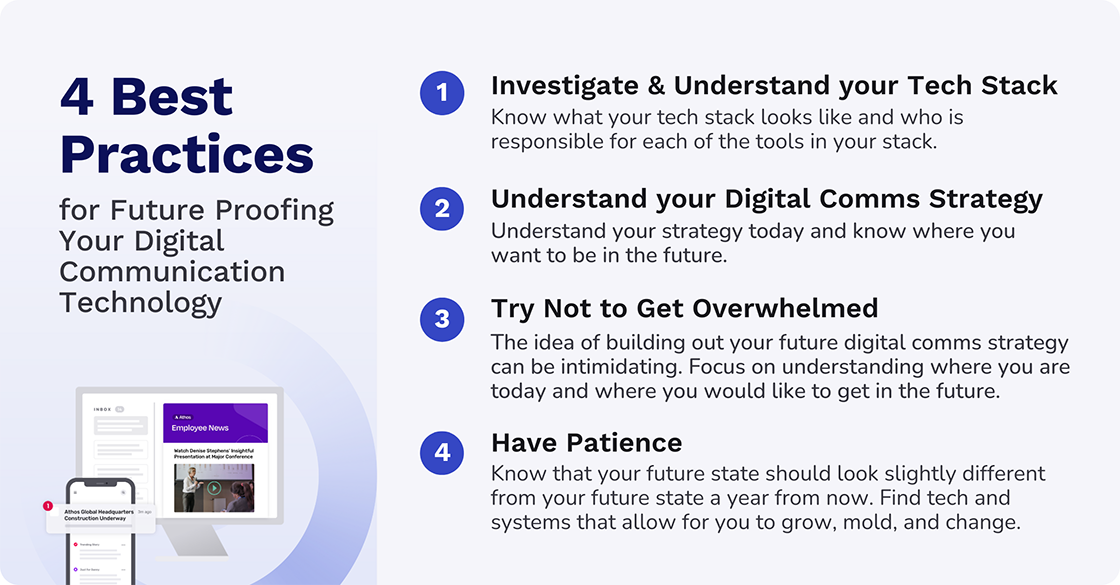 Internal Communication Pains
Internal Communication Pains
How important is your digital communication technology? We know that it’s vital! That’s why it’s so important to future proof your internal comms stacks. Here’s how.


Choosing the right internal communications software is a delicate process. Evaluate yourcommunication goals and needs, and select the right software with confidence using our Internal Communication Software Buyer’s Guide.
Access NowIn today's digital world, effective communication is the lifeblood of any business. But with an ever-changing landscape of platforms and tools, including the far-reaching impact of artificial intelligence (AI), simply having the latest technology isn't enough. To stay ahead, businesses need to prioritize future-proofing their digital communication infrastructure.
By investing in flexible and scalable solutions, organizations can ensure seamless communication across teams and with clients, regardless of new technologies that emerge. This forward-thinking approach keeps your communication channels robust and adaptable, fostering long-term success.
But what does future proofing mean, and what does it entail? What happens if organizations don’t future-proof their digital communication channels and technologies?
Future-proofing your digital communication stack is the last of Head of Customer Success at Cerkl, Maddy Rieman’s top 10 internal communication challenges with tactical solutions. If you’ve been following the posts we’ve published about the workshop we held at the 11th Annual Strategic Internal Communications - West Conference in San Francisco in February, you’ll know why this is so important.
For the past two months, we have been publishing posts focused on pain points identified by Maddy during the workshop, together with information and pointers on how to conquer these challenges.
In this, the last post of the series, we are delving into what future-proofing is, why it’s important, and the risks of not embracing the future-proofing challenge. You will also learn about the challenges we face when using digital technology and the best practices to follow when future-proofing digital communication technologies.
“When we future proof our comms stack, we implement software solutions so that they remain effective. Ultimately, it’s vital to prepare your solutions for years ahead, so that you can adapt to the times rather than needing replacements or an expensive overhaul.”
Maddy Rieman
Maddy explains that both future-proofing and tech stack are very common phrases used in the technology industry. “We talk a lot about them at Cerkl but these might not necessarily be the most common phrases used in the IC world.”
In the world of internal communications (IC), many people refer to IC tech stacks. Examples Maddy cites are:
Both comms stacks and tech stacks are technologies we use to achieve a specific goal. While tech stacks focus on tools used to build or run something, comms stacks focus on the infrastructure that enables communication between devices. It deals with the technical aspects of transmitting data, ensuring messages get from point A to B.
We have chosen to focus on digital communication technology, a broader term that encompasses all the tools and platforms we use for digital communication. It includes generic technologies like email, video conferencing software, social media platforms, and instant messaging apps. These applications rely on the comms stack to function.
Ultimately, it is vital to future-proof all elements of these technologies.
A Gartner report, Top 5 Priorities for HR Leaders in 2024 states that 56% of HR leaders agree that their HR technology solutions and strategy don’t match their current or future business needs. These needs include digital transformation. So, it’s not surprising that an even higher percentage (60%) aren’t certain about the impact of evolving technological trends on HR and skilled and valuable members of the workforce (talent). Additionally, they state that HR technology leaders are uncertain about which technologies to adopt — including generative AI. Another problem is that HR functions are unprepared to implement these technologies.
While the Gartner report focuses on HR, the same challenges apply to internal communicators and digital communication. To develop a successful digital communication strategy that includes an effective comms stack, internal communicators need to know and understand the tools they are working with.
Gallagher’s definitive State of the Sector 2023/24 report delves into the main barriers to success in 2024 for internal communicators. Among those, 24% of respondents say internal communication technologies and channels don’t fit their purpose. And 7% believe their organizations are using too many channels.

One thing that many internal communicators often don’t know or realize is that trying to solve a pain quickly, its unintended consequences may result in more pain in the future, says the founder and CEO of Cerkl Tarek Kamil. “This involves processes and maintenance of each new channel and tool, often not accompanied by additional resources to the internal communications team. In addition to creating more work, multiple siloed digital communication channels and/or tools will lead to less engagement for your employees, not more.”
This results in them seeing more irrelevant content, either because it’s not targeted to them and/or because they have already seen it on another channel.
Maddy tells us that typically there are two groups of internal communicators:

Either way, most of the time internal communicators aren’t aware of what their digital communication tech looks like, says Maddy. If they are, they usually only know the baseline platform. Apart from which, typically, different internal teams own different elements of the stack.
This, in itself, can be a problem as Tarek points out. “Solving multiple pains with multiple solutions ultimately creates more work for the communicator and a poor experience for your employees.” Also, “Most internal digital communication technology solutions are focused on solving a very narrow set of pains.” These include email analytics, email design, making your intranet stickier, newsletter production, collaboration, and finding a mobile app to communicate with deskless workers.
Maddy highlights the importance of streamlining the employee experience in this context. “When there are too many systems in too many places to manage, it’s difficult to effectively choreograph a streamlined employee experience. This is, quite simply, because employees don’t know where to go to find information they need.”
Tarek’s advice when solving a pain is easy integration. “Look for tools that play nicely with others.” You need to “find tools and solutions that are agnostic to your people’s data source(s) so these changes won’t hold you up for months.” For example, if the company is going to launch a mobile app to communicate with deskless workers, “is that a new vendor search and another mouth to feed, or is it an add-on to what you’re already doing?”
A major challenge is that those involved with future-proofing digital communication need the ability and knowledge to do this. The solution, says Maddy, is for internal communicators “to work alongside their IT team to understand what their tech stack looks like. If they have a grasp on what the future of their comms looks like, they can work together to map out how to future proof them.”
But there are, of course, other challenges an internal communicator has to face when future proofing their digital communication strategy. These are some of them.
Maddy reveals that the biggest hurdle Cerkl finds with hundreds of organizations and their teams is that internal communicators must navigate the internal waters of their organization to uncover the tools that are being used. Additionally, workflows must pass through the system, those who own the tools to get them on board need to understand why the new tool is important.
Ensuring teams have the appropriate stakeholder buy-in before, during, and after purchasing a new comms tool can be a challenge. “At large companies, you will find that the technical teams become more hyper-focused on their role and responsibilities,” says Maddy.
The reality is that IT could be a very general group of stakeholders that doesn’t have the various systems that need to be integrated for successful configuration and launch. “Typically, there’s a team that owns SharePoint, another that owns O365, another team that owns DNS configuration, and another that owns people data etc.”
Like internal communications budgetary constraints, these could be a big challenge because ROI may not be immediately clear.
Earlier, we mentioned a couple of barriers that Gallagher’s State of the Sector 2023/24 report identified. The lack of budget and/or financial resources hits this list at number 3, with 25% of respondents saying it’s the problem they have.
Tarek agrees. “We frequently hear that communications teams are woefully under-resourced. We hear that the solutions and channels they have deployed don’t work well together. And we hear that getting a holistic view of what’s really going on across the organization is nearly impossible due to siloed tools.”
Integrating new communication tools with existing legacy systems can be complex and time-consuming. There might be compatibility issues or a need for custom development, further adding to the cost and timeline.
It is also important to use technologies that follow open standards and integrate well with other business tools, in this way ensuring flexibility
While data security is essential, it is a huge challenge. After all, integrating multiple platforms creates a complex data landscape. Internal communicators need to ensure the chosen tools prioritize data security with robust features and user access controls to comply with regulations and protect sensitive information.
According to Gallagher’s State of the Sector 2023/24 report, AI is the number one internal communications trend in 2024. Their report states that 68% of organizations believe AI will have an impact in the next five years, and 44% give it a very high importance.
Whether it’s GenAI or another form of machine learning, in this day and age, digital communication technologies should have the capability to streamline workflows and save communicators’ time.
To ensure that when your business grows or your communication needs change, the system can be adapted by adding features or users, says Maddy. Choose a platform that allows for easy user management with features like user roles, permission controls, and the ability to add or remove users efficiently. This will ensure smooth onboarding for new employees and will simplify access management as your workforce grows.
Future-proofing isn't just about the latest gadgets. It's crucial to align the communication strategy with the organization's goals. Internal communicators need to demonstrate how the chosen tools will improve communication effectiveness and contribute to overall business objectives.

Hopefully, you are now convinced that it is essential to future-proof everything related to your digital communication technologies. These are Maddy’s top tips:

Broadcast was built from the ground up with the internal communicator in mind. Modular in nature, Broadcast can scale as the needs of your organization evolve.
Broadcast not only plays nicely with all major people's data sources (e.g. Workday, UKG, SAP, Peoplesoft, ADP, Active Directory), and communicators aren’t limited to how many people data sources can be integrated. This means that communicators are no longer dependent on IT or HRIS to pull people's data, build distribution lists, and so on.
Whether your communications team is looking for a modern, scalable internal email solution with full analytics capabilities, an omnichannel publishing option, or a solution to communicate with deskless workers, your communications team can rest assured that as your organization grows, your internal communications solution will be able to support you.
Are you happy with your current digital communication solutions? If not, why don’t you take advantage of our free opportunities? Cerkl has a free guide that will help you work out how to choose IC software. Why not give it a try?
What are some examples of digital communication? Examples of digital communication include email, social media, instant messaging, and video conferencing. These tools allow us to exchange information and ideas electronically across all distances, near and far.
What is the function of digital communication technology? This technology facilitates the exchange of information between people through electronic devices. It has revolutionized the way we connect, making communication faster, more efficient, and more accessible.
Is AI a digital technology? Yes, AI is a digital technology. It uses complex algorithms and software to process information and simulate intelligent behavior in a digital environment.